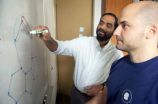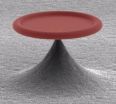Fortify HIT contracts with education and ethics to protect patient safety, say informatics experts
AMIA takes position on HIT vendor contracts
2010-11-12
(Press-News.org) Bethesda, MD—An original and progressive report on health information technology (HIT) vendors, their customers and patients, published online today, makes ground-breaking recommendations for new practices that target the reduction or elimination of tensions that currently mar relationships between many HIT vendors and their customers, specifically with regard to indemnity and error management of HIT systems. In light of the Obama Administration's $19 billion investment in HIT, paid out in ARRA stimulus funds, these recommendations are particularly significant in helping to foster greater use of electronic health records and other tools in the transition from paper records, largely understood to be a hindrance to quality patient care.
The recommendations, adopted by AMIA— the association of informatics professionals and a trusted authority in the HIT community—strive to imbue the HIT vendor-customer relationship with transparency, veracity, and accountability through collaborative education focused on the installation, configuration and use of HIT systems, in combination with enterprise-wide ethics education to support patient safety. The recommendations are the result of deliberations by an AMIA Board-appointed Task Force. The position statement will appear in the January/February 2011 print edition of JAMIA, the scholarly peer-reviewed journal of informatics in health and biomedicine, co-published by AMIA and the BMJ Group.
"There was a need to consider, study and analyze questions of appropriate oversight," said AMIA Board Chairwoman Nancy M. Lorenzi, PhD, Assistant Vice Chancellor for Health Affairs and Professor of Biomedical Informatics, Vanderbilt University. "With as much interest and investment in HIT as there is today, AMIA—an unbiased third party—wanted to take a fresh look at gray areas that currently exist between vendors and their customers to see where new practices could be implemented to better support patient outcomes and protect patients, who these systems ultimately serve. We think these recommendations do an excellent job of addressing fairness and balancing accountability in the HIT marketplace and in the health sector."
The report, titled "HIT Vendors, their customers and patients: New challenges in ethics, safety, best practices and oversight," makes specific recommendations on Contract Language, Education and Ethics, Ethical Standards, User Groups, Best Practices, and Marketing. An additional section addresses Regulation and Oversight of the HIT Industry and next steps.
The report's first author is Kenneth W. Goodman, PhD, FACMI, director of the University of Miami Bioethics Program. Dr. Goodman chaired the Task Force responsible for the report, a group of AMIA members comprising nationwide representatives of academia, industry, and leading healthcare institutions.
"AMIA provided an important forum in which complex and sometimes conflicting positions were candidly discussed, analyzed and balanced," said Dr. Goodman. "HIT systems are ubiquitous these days and need better oversight. These recommendations demonstrate a high-value commitment to patient safety, quality care, and innovation—healthcare goals sometimes difficult to reconcile. These recommendations," he added, "can help individual institutions do more to support successful HIT implementation."
Among the recommendations is contract language specified to protect patient safety and to spell out the shared responsibility that vendors and their customers have for successful implementation. "Hold harmless" clauses in contracts between vendors and purchasers or clinical users, that absolve vendors for errors or defects in their software, are declared unethical by AMIA.
The AMIA position states that "safe and successful HIT systems further require ethics education, which has become a standard part of professional development in the corporate world." HIT vendors and their clients are urged to adopt enterprise-wide ethics education to parallel what accrediting healthcare organizations require. Standards for corporate conduct and subsequent education about such standards are also recommended. A variety of informational tools, many aimed for post-market use, are cited among best practices to assist institutions and clinical practices in achieving optimal HIT implementation.
AMIA President and CEO Edward H. Shortliffe, MD, PhD, praised the Task Force and its accomplishment. "This group of informatics and industry leaders recognized the need to meld business ethics into successful adoption of HIT. Their recommendations balance the forces that drive the competitive HIT marketplace with the practical needs of clinicians, patients, researchers, public health workers and officials. AMIA stands by their work and hopes these recommendations will be embraced by the HIT community."
INFORMATION:
Full text of the AMIA position on HIT vendors, their customers and patients is available online at www.jamia.org as an open-access document. Its co-authors are Eta Berner, EdD, FACMI, professor of health informatics at University of Alabama at Birmingham; Mark A. Dente, MD, GE Healthcare IT; Bonnie Kaplan, PhD, FACMI, lecturer at Yale University School of Medicine, and Bioethics Center Scholar at the Interdisciplinary Center for Bioethics at Yale's Institution for Social and Policy Studies; Ross Koppel, PhD, professor in the Sociology Department and in School of Medicine at University of Pennsylvania; Donald Rucker, MD, vice president and chief medical officer at Siemens Healthcare U.S.A.; Daniel Z. Sands, MD, MPH, FACMI, director of medical informatics at Cisco Internet Business Solutions Group, and clinical assistant professor of medicine at Harvard Medical School; and Peter Winkelstein, MD, MBA, chief of the Division of General Pediatrics at Women & Children's Hospital of Buffalo, and chief medical informatics officer at University of Buffalo Physicians Group.
AMIA, the leading professional association for informatics professionals, serves as the voice of the nation's top biomedical and health informatics professionals and plays an important role in medicine, health care, and science, encouraging the use of data, information and knowledge to improve both human health and delivery of healthcare services.
ELSE PRESS RELEASES FROM THIS DATE:
Graphene's strength lies in its defects
2010-11-12
PROVIDENCE, R.I. [Brown University] — The website of the Nobel Prize shows a cat resting in a graphene hammock. Although fictitious, the image captures the excitement around graphene, which, at one atom thick, is the among the thinnest and strongest materials ever produced.
A significant obstacle to realizing graphene's potential lies in creating a surface large enough to support a theoretical sleeping cat. For now, material scientists stitch individual graphene sheets together to create sheets that are large enough to investigate possible applications. Just as sewing ...
New analysis explains formation of bulge on far side of moon
2010-11-12
SANTA CRUZ, CA--A bulge of elevated topography on the farside of the moon--known as the lunar farside highlands--has defied explanation for decades. But a new study led by researchers at the University of California, Santa Cruz, shows that the highlands may be the result of tidal forces acting early in the moon's history when its solid outer crust floated on an ocean of liquid rock.
Ian Garrick-Bethell, an assistant professor of Earth and planetary sciences at UC Santa Cruz, found that the shape of the moon's bulge can be described by a surprisingly simple mathematical ...
Contact among age groups key to understanding whooping cough spread and control
2010-11-12
ANN ARBOR, Mich.---Strategies for preventing the spread of whooping cough---on the rise in the United States and several other countries in recent years---should take into account how often people in different age groups interact, research at the University of Michigan suggests.
The findings appear in the Nov. 12 issue of the journal Science.
Thanks to widespread childhood vaccination, whooping cough (pertussis) once seemed to be under control. But the illness, which in infants causes violent, gasping coughing spells, has made a comeback in some developed countries ...
Fruit flies lead scientists to new human pain gene
2010-11-12
Boston, Mass. - While it has become clear in recent years that susceptibility to pain has a strong inherited component, very little is known about actual "pain genes" and how they work. In the November 12th issue of Cell, researchers at Children's Hospital Boston and their collaborators report on a novel human pain gene. People with minor variations in this gene showed clear differences in susceptibility to acute heat pain and chronic back pain. Corroborating mouse studies give some clues as to how the gene controls pain sensitivity. The gene was uncovered in a genome-wide ...
All-optical transistor
2010-11-12
Controlling and modulating the flow of light is essential in today's telecommunications-based society. Professor Tobias Kippenberg and his team in EPFL's Laboratory of Photonics and Quantum Measurements have discovered a novel way to couple light and vibrations. Using this discovery, they built a device in which a beam of light traveling through an optical microresonator could be controlled by a second, stronger light beam. The device thus acts like an optical transistor, in which one light beam influences the intensity of another.
Their optical microresonator has two ...
Having severe acne may increase suicide risk
2010-11-12
Individuals who suffer from severe acne are at an increased risk of attempting suicide, according to a paper published on bmj.com today.
The study also finds that an additional risk may be present during and up to one year after treatment with isotretinoin, a commonly prescribed drug for severe acne. However, the authors stress that this additional risk is most likely due to the acne itself, rather than the drug treatment.
Isotretinoin (commonly marketed as Roaccutane, Accutane, Amnesteem, Claravis, Clarus or Decutan) has been used to treat severe acne since the 1980s. ...
Thousands of turtles captured in Madagascar despite ban
2010-11-12
New research has revealed up to 16,000 endangered turtles are being caught each year by villagers in just one region of Madagascar, despite a government ban.
Researchers from the University of Exeter and Blue Ventures Conservation say the figure, thought to be a conservative estimate, is the first direct assessment of turtle exploitation on the island.
The study highlights the extent of small-scale fishing, traditionally very difficult to monitor, and could be vital in finding a way to sustainably manage turtle fishing in the region.
Dr Annette Broderick, from the ...
Study points to window of opportunity for successful autism therapy
2010-11-12
"The biggest surprise to me was that we could rescue the autistic phenotype [in the human cells] to something close to normal," said Alysson Muotri of the University of California San Diego.
The researchers made the discovery by first transforming adult cells taken from patients with Rett Syndrome into induced pluripotent stem cells (iPS cells) using an established cocktail. iPS cells look and act very much like embryonic stem cells.
Those stem cells were able to form functional neurons in cell culture. However, neurons derived from Rett Syndrome patients exhibited ...
A long history of pain: Study finds pain gene common to flies, mice and humans
2010-11-12
They show that one of those genes in particular has a long evolutionary history, as evidenced by the fact that it plays a role in pain sensing in flies, mice and humans. At least in mice, the newly described gene is also linked to a condition known in humans as synesthesia, in which one sensory experience triggers the perception of another sense.
"We found lots of new genes and pathways that have never been implicated in pain before," said Josef Penninger of the Institute of Molecular Biotechnology of the Austrian Academy of Sciences.
"From a helicopter view, this ...
23 percent of young people get into fights when they go out at night
2010-11-12
Night-time violence among young Spaniards is becoming ever more common, according to a research study carried out by the European Institute of Studies on Prevention. The study shows that 5.2% of young people carry weapons when they go out at night, 11.6% have been attacked or threatened, and 23% have got into a fight at some time.
"Reports about young people being attacked or injured in fights when they go out at night are becoming increasingly common", Amador Calafat, lead author of the study and a researcher at the European Institute of Studies on Prevention (IREFREA), ...
LAST 30 PRESS RELEASES:
Tracing the quick synthesis of an industrially important catalyst
New software sheds light on cancer’s hidden genetic networks
UT Health San Antonio awarded $3 million in CPRIT grants to bolster cancer research and prevention efforts in South Texas
Third symposium spotlights global challenge of new contaminants in China’s fight against pollution
From straw to soil harmony: International team reveals how biochar supercharges carbon-smart farming
Myeloma: How AI is redrawing the map of cancer care
Manhattan E. Charurat, Ph.D., MHS invested as the Homer and Martha Gudelsky Distinguished Professor in Medicine at the University of Maryland School of Medicine
Insilico Medicine’s Pharma.AI Q4 Winter Launch Recap: Revolutionizing drug discovery with cutting-edge AI innovations, accelerating the path to pharmaceutical superintelligence
Nanoplastics have diet-dependent impacts on digestive system health
Brain neuron death occurs throughout life and increases with age, a natural human protein drug may halt neuron death in Alzheimer’s disease
SPIE and CLP announce the recipients of the 2025 Advanced Photonics Young Innovator Award
Lessons from the Caldor Fire’s Christmas Valley ‘Miracle’
Ant societies rose by trading individual protection for collective power
Research reveals how ancient viral DNA shapes early embryonic development
A molecular gatekeeper that controls protein synthesis
New ‘cloaking device’ concept to shield sensitive tech from magnetic fields
Researchers show impact of mountain building and climate change on alpine biodiversity
Study models the transition from Neanderthals to modern humans in Europe
University of Phoenix College of Doctoral Studies releases white paper on AI-driven skilling to reduce burnout and restore worker autonomy
AIs fail at the game of visual “telephone”
The levers for a sustainable food system
Potential changes in US homelessness by ending federal support for housing first programs
Vulnerability of large language models to prompt injection when providing medical advice
Researchers develop new system for high-energy-density, long-life, multi-electron transfer bromine-based flow batteries
Ending federal support for housing first programs could increase U.S. homelessness by 5% in one year, new JAMA study finds
New research uncovers molecular ‘safety switch’ shielding cancers from immune attack
Bacteria resisting viral infection can still sink carbon to ocean floor
Younger biological age may increase depression risk in older women during COVID-19
Bharat Innovates 2026 National Basecamp Showcases India’s Most Promising Deep-Tech Ventures
Here’s what determines whether your income level rises or falls
[Press-News.org] Fortify HIT contracts with education and ethics to protect patient safety, say informatics expertsAMIA takes position on HIT vendor contracts



